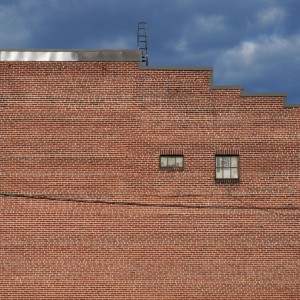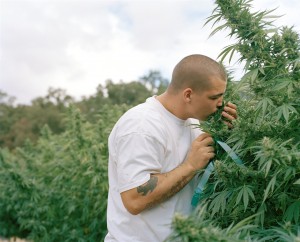A Love Supreme at the Philadelphia Photo Arts Center provides a cross-section of photographers and techniques, as well as content that ranges from near-documentary to almost complete abstraction. It is a great sampling of images that whets the palate but leaves the viewer seeking more.

Some of the most curious and formally-potent images in PPAC’s second annual juried group show are by Lisa Boughter. The environments Boughter captures are sparse and often in some degree of disrepair. They depict locations that are brimming with synthetic and strangely familiar objects: a garage door, a parking lot, a brick wall, and a deer-shaped lawn-ornament. Yet all are presented in a way that verges on the surreal.
Boughter’s untitled photos are both minimal and complex. Bathed in a sea of brick-red, for example, the perceived urban bustle outside the frame in “Untitled,” from the series Periphery, is entirely silent and allows us time to reflect. As a viewer closely examines the patterns, the nearly infinite subtleties of the wall crawl out from their hiding places.

Maureen Drennan takes us for a stroll to greener pastures in her series of photos from an outdoor marijuana growing operation. Politically and socially a hot topic, the plants portrayed in her photo The Garden grow in rows, and appear as benign as cornstalks.
And what garden would be complete without its Adam? In this photo, one of the workers gently holds the buds of a live plant in his hand and breathes in the odor. For many people, this is quite the dream(y) job – a true Eden for those in the cannabis culture. Awash in natural greens and browns, these photos make one wonder why the harvest of this plant carries such a harsh stigma.

Moving Day by Steven Beckly appears candid at first, but the crisp lighting and deliberate composition lead the viewer to believe otherwise. In this photo, a couple lies on the floor behind cardboard boxes in a sparse room, as they share an exhausted embrace. People’s familiarity with the process of moving day makes the weary nostalgia of this observation quite universal, and many of Beckly’s photos share the qualities of bright highlights and some portion of exposed human skin. These traits serve to reinforce the personal and interpersonal play apparent in the situations Beckly illustrates.

Gina Delia digitally stitches together opposing scenes, connecting them by only their shared darkness. While the lighter areas are heavily saturated and beautifully textured, the deep chasms of darkness, which both separate and connect her scenes, make these photos a wonderful contrast to Beckly. In Edge of Darkness, the cliff-like corner of a stone falls off into pitch blackness. The shadows divide two very different, yet structurally exquisite forms: the close-up of an insect exoskeleton and the self-lit scene of a street light and power lines.
The other artists in the show are also notable in their own respect. Daney Saylor‘s bright, yet barren landscapes, Emily Rooney and Andrew Burgh‘s dark abstractions, and the work of Sebastian Collett and Gregory Davis round out A Love Supreme‘s sampler package.
If this show has one major downside it is the fact that it is more of a tasting menu of photographers and appears somewhat staccato in its transitions. This is undoubtedly the intent of the show – to provide a sampling of various images – but many of these bodies of work could probably have filled the space on their own. If PPAC’s intent was to drive visitors to the websites of participating artists, then they definitely succeeded.









